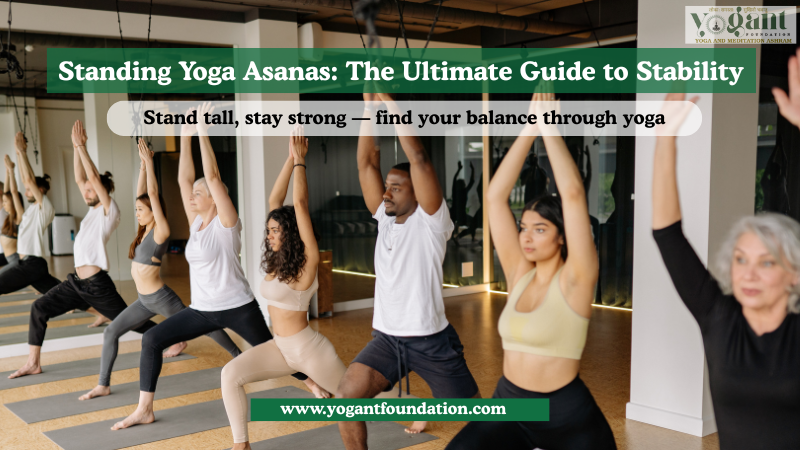Yoga is much more than a simple exercise. The journey to harmony is a part of yoga. Standing yoga asanas are one type. These poses are the basis for stability, strength and awareness. These standing asanas can be used by both beginners and experienced practitioners to ground themselves, open up energy channels, and prepare them for advanced poses.
In this detailed guide we will examine the significance, benefits and details of standing yoga postures. Also included are variations, spiritual insights and instructions. Once you finish, it will become clear why the standing yoga asanas and variations are so important to every yoga journey.
What Are Standing Yoga Asanas?
Standing Yoga Asanas are yoga performed standing up, using the core and legs. Standing asanas provide the foundation for mental and physical focus. Asanas require active engagement and mindful awareness, which makes them incredibly powerful for improving posture and grounding your energy.
Why Standing Yoga Asanas Matter?
Standing poses in yoga symbolize the connection to Earth. Standing tall and balanced aligns you with strength, stability, and awareness. These asanas encourage:
- Rootedness– a deep connection with the earth.
- Balance– Harmonizing the two sides of your body and mind.
- Vitality– Activating prana energy (life force) in the entire system.
The Importance of Standing Yoga Asanas in Daily Practice
The foundation for physical yoga is standing yoga asanas. Standing yoga asanas are usually the first part of any sequence, warming up muscles, increasing circulation, and calming the mind.
Standing poses are important for every yoga practice.
- Strengthen and Develop Endurance: The postures in this video strengthen and develop the muscles of your legs, hips, and core.
- Improve Balance: These exercises train the body’s proprioception, or sense of balance.
- Alignment Improvement: Stand asanas to correct posture.
- Improve Energy Flow: When you open up the hips chest and shoulders energy will flow through your body.
- Improve Mindfulness Maintaining the poses you are doing requires concentration.
Top 10 Standing Yoga Asanas and Their Benefits
Learn the most powerful and popular Yoga Standing Asanas.
1. Tadasana (Mountain Pose)
Meaning: “Tada” means mountain- symbolizing strength and stability.
Type: Foundation Standing Pose
How to Practice:
- Standing tall, with toes together and heels apart, touch your toes, while keeping your feet close.
- Spread the weight equally on both legs.
- Lift chest, engage thighs, and tuck in tailbone.
- Keep your palms on your thighs or stretch out your arms.
- Please take a deep breath and hold it for five to ten seconds.
Benefits:
- Balance and posture are improved.
- Legs, ankles, and knees are strengthened.
- Focus and awareness are increased.
- The spine is aligned, and the grounding energy is enhanced.
2. Vrikshasana
Meaning: The word “Vriksha”, which means tree, is used to describe this pose. It reflects the growth of a tree and its rootedness.
How to Practice:
- Tadasana is a posture that will help you to stand tall.
- Weight shift to your left leg.
- Put the left inner thigh on your right foot.
- Namaste is the act of bringing palms together.
- Focus your attention on an object for balance.
Benefits:
- Concentration and balance are improved.
- It strengthens the calves and legs, as well as the ankles.
- It improves mental stability and posture.
- This encourages the use of patience and grounding.
3. Trikonasana (Triangle Pose)
Meaning: “Trikona” means triangle- representing strength and stability.
How to Practice:
- Standing with your feet apart is a good idea.
- Right foot 90 degrees outward and left foot slight inward.
- Straighten your arms and extend them parallel to the ground.
- Bring the right hand down to your shins or the floor.
- Stretch your left arm upwards and look up.
Benefits:
- Stretches the spine and the waist
- The hips, shoulders, and back are opened.
- Increases energy and digestion.
- Increases body flexibility and coordination.
4. Virabhadrasana I (Warrior Pose I)
Meaning: Meaning is named for Virabhadra who was a powerful warrior in Hindu mythology.
How to Practice:
- Standing with your feet at a distance of 3-4 feet.
- The right foot 90 degrees, and the left 45 degrees.
- Straighten the right leg directly over the ankle.
- Spread your arms out, palms together.
- Hold the position and gaze upward.
Benefits:
- This exercise strengthens the legs, shoulders, and back.
- Increases confidence and stamina.
- Opening the chest and lungs.
- Focus and inner strength are increased.
5. Virabhadrasana II (Warrior Pose II)
How to Practice:
- Take a broad view.
- Right knee bent, turn right foot to the outside.
- Stretch arms sideways, palms facing down.
- Look at the fingertips on your right.
Benefits:
- Enhances endurance and stability.
- The ability to concentrate and maintain balance is improved.
- This exercise strengthens your legs, ankles, thighs and calves.
- The courage, willpower, and determination to succeed are encouraged.
6. Parsvakonasana (Side Angle Pose)
Meaning: “Parsvakonasana” means “side angle posture.”
How to Practice:
- Rest the elbow of Warrior II on the knee.
- Create a diagonal by extending the left arm above your head.
- Maintain a straight left leg and an open chest.
Benefits:
- Stretches your entire body.
- Increases blood circulation and digestion.
- Legs and hips are strengthened.
- It promotes stamina and flexibility.
7. Utkatasana (Chair Pose)
Meaning: “Utkata” means powerful- symbolizing determination and strength.
How to Practice:
- Standing in Tadasana.
- As you inhale, raise your arms above your head.
- As if you were sitting on a chair that is invisible, exhale while bending your knees.
- Hold your chest up and lift it for five to ten breaths.
Benefits:
- The spine, hips, and thighs are strengthened.
- Tone your core and glutes.
- Increases willpower, stability, and mental strength.
- It also helps to build endurance and discipline.
8. Garudasana (Eagle Pose)
Meaning: The mythical Bird Garuda is a symbol of freedom and power.
How to Practice:
- Standing in Tadasana.
- Wrap the right leg around the left.
- Right elbow crossed under left.
- Focus on balance and forward.
Benefits:
- Enhances focus and coordination.
- This stretch stretches the shoulders, hips, and thighs.
- Stabilizes and concentrates the mind.
- Both sides of your body and brain should be balanced.
9. Ardha Chandrasana (Half Moon Pose)
Meaning: “Ardha” means half, “Chandra” means moon- symbolizing calmness and grace.
What to Do:
- Place your right hand on the block or floor in Trikonasana.
- Raise the left leg parallel with the floor.
- Face forward, upward, or outward while extending the left arm.
Benefits:
- Legs and ankles are strengthened.
- Enhances coordination and stability.
- Opens the chest and expands it.
- Stress relief and calms down the mind.
10. Prasarita Padottanasana (Wide-Legged Forward Bend)
Meaning: Forward bends that are both energizing and soothing.
How to Practice:
- Standing with your feet apart is a good idea.
- Exhale and fold your arms forward.
- Relax your head and place your palms down on the floor.
Benefits:
- Hamstrings and spine are stretched.
- Relaxes and relieves fatigue.
- Increases the blood flow to your brain.
- Encourages introspection and calmness.
The Physical Benefits of Standing Yoga Asanas
1. Strengthens Bones and Muscles:
Standing asanas work large muscle groups, including the legs, hips, and core. They improve endurance and balance. The weight-bearing pose also increases bone density and reduces the risk of osteoporosis.
2. Increased Flexibility:
Stretching tight muscles and joints with regular practice increases flexibility, mobility, and agility.
3. Increases circulation:
Standing poses improve blood circulation and lymphatic flow, which helps to deliver oxygen and support detoxification.
4. Posture and Alignment Improved:
A consistent practice will correct slouching, misalignment, and promote an upright, confident posture.

The Mental and Emotional Benefits of Standing Yoga Asanas
1. Mindfulness Increases:
To maintain balance, you must be fully aware and anchor your mind to the moment.
2. Building inner strength and confidence:
Self-confidence and inner strength grow as you learn challenging poses.
3. Relaxation and relief from stress:
The nervous system is calmed by deep breathing and grounding positions. This helps release emotional blocks and tension.
4. Focuses and Stabilizes:
Standing asanas train the mind to remain steady even in discomfort–mirroring balance in life’s challenges.
Standing Yoga Asanas for Beginners
Start simple if you are new to yoga. Standing poses are easy and effective.
- Tadasana (Mountain Pose)- Focus on breath and balance.
- Vrikshasana (Tree Pose)- Practice patience and grounding.
- Virabhadrasana II (Warrior II)- Strengthen the legs and core.
- Trikonasana (Triangle Pose)- Stretch the side body and open the hips.
- Utkatasana (Chair Pose)- Build stamina and determination.
To ensure proper alignment, practice yoga under the supervision of a certified teacher.
Standing Yoga Asanas for Advanced Practitioners
Explore deeper standing poses like:
- Natarajasana (Dancer Pose)– Increases flexibility and grace.
- Utthita Hasta Padangusthasana (Extended Hand-to-Big-Toe Pose)- Enhances focus and core stability.
- Parivrtta Trikonasana (Revolved Triangle Pose) – Detoxifies the spine and gives it energy.
- Virabhadrasana III (Warrior III)– Strengthens mental focus and willpower.
Asanas that challenge your balance, physical control, and focus will help you to create a connection between breath and body.
Common Mistakes to Avoid in Standing Yoga Asanas
- Unequal weight distribution: Do not lean on just one leg, but balance evenly.
- Stiff Knees: Micro-bend the knees to avoid strain.
- Bad Alignment: Maintain spinal integrity by engaging core muscles.
- Breathing deeply: Always breath deep and consistently.
- Force Flexibility: Focus on Stability first, then progress slowly.
Tips for Practicing Standing Yoga Asanas Safely
- Prepare the body by warming up properly: Gently rotating joints.
- Props can be used to help align: Walls and blocks are useful.
- Barefoot Practice: Increases grounding and grip.
- Engage The Core: Protects and improves your balance.
- Be Aware: Pay attention to your body.
The Spiritual Essence of Standing Yoga Asanas
Standing Yoga asanas offer spiritual benefits in addition to their physical ones. The standing asanas help us connect with our (Muladhara), the center for stability, grounding, and security. We feel confident and safe when this chakra is balanced.
Standing poses help us to develop patience, humility, and stillness in the midst of movement. They also mirror life’s balance between effort and surrender.
Standing Yoga Asanas and Pranayama: A Perfect Combination
Standing postures that incorporate Pranayama (breath-control) enhance energy flow and concentration. These combinations will help you focus and increase energy flow.
- Tadasana & Deep Breathing: Promotes clarity, grounding & stability.
- Virabhadrasana & Ujjayi Pranayama: Increases focus and internal heat.
- Trikonasana & Anulom Vilom: Equilibrates the two hemispheres in the brain.
Yoga becomes a meditation-in-motion when movement and breathing are combined.
Daily Routine with Standing Yoga Asanas
This is a 20-minute sequence that you can do every day:
- Tadasana (Mountain Pose) – 2 minutes
- Vrikshasana (Tree Pose) – 2 minutes each side
- Trikonasana (Triangle Pose) – 2 minutes each side
- Virabhadrasana I & II (Warrior Poses) – 4 minutes
- Utkatasana (Chair Pose) – 2 minutes
- Ardha Chandrasana (Half Moon Pose) – 2 minutes each side
- Prasarita Padottanasana (Wide-Leg Forward Bend) – 3 minutes
Continue with Shavasana , or deep breath to finish for 5 minutes.
Conclusion: Standing Tall in Life with Yoga
Asanas that are performed standing are not just physical poses, but also symbolic. These asanas remind us of the importance of staying grounded, like a tree; stable, like a mountain, and versatile, like the wind.
A regular practice strengthens your body, but it also helps to calm the mind and lift the spirits. Standing consciously and moving mindfully while breathing deeply transforms every pose into a meditation.
Next time you get on your yoga mat, keep in mind that each Standing Yoga Asana offers an opportunity to become stronger, more stable, and present.



